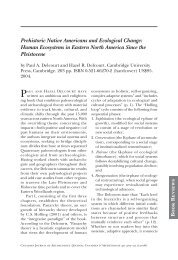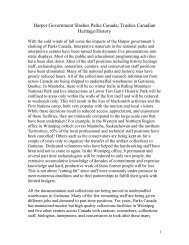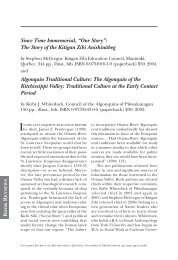Ames, Christopher J.H. 1 , Carlos E. Cordova 2 , April Nowell 3 , and Michael Bisson 11Department of Anthropology, McGill University, Montreal, Canada2Department of Geography, Oklahoma State University, Stillwater, OK, USA3Department of Anthropology, University of Victoria, Victoria, BC, CanadaHominin occupation, landscape evolution, and middle and late Pleistoceneenvironmental change in the north Azraq Basin in Jordan’s <strong>de</strong>sert interior (31) Recentarchaeological excavation and geomorphic survey in the former bed of the North Azraqmarsh has i<strong>de</strong>ntified a complex stratigraphic succession characterized by cyclicalaggradations of lake and/or marsh <strong>de</strong>posits indicative of wet periods, intercalated witherosional unconformities and wind-blown sediments suggestive of drier environments.Archaeological material embed<strong>de</strong>d within this stratigraphic sequence typologically spansthe past 250,000 years, including Lower, Middle, Upper, and Epipaleolithic industries.Coupled with the evi<strong>de</strong>nce of upland lake terrace <strong>de</strong>posits and paleo-shorelines in thebasalt flows that flank the north Azraq basin, we hypothesize that the Azraq region andits inhabitants experienced dramatic environmental fluctuations since at least the middlePleistocene, corresponding to at least three distinct paleo-environments, includingperennial lakes we suspect occurred during parts of MIS 9, MIS 7, and MIS 5. We alsobelieve these fluctuations play a critical role in un<strong>de</strong>rstanding the spatial distribution ofarchaeological material throughout the current Azraq landscape.Amundsen-Meyer, Lindsay (Department of Archaeology, University of Calgary)Footprints in the Forest and Islands in a Sea of Grass: A Comparison of Blackfoot andKayapó Agroforestry Practices (15) The Americas contain a diverse array of past andpresent cultures in highly varied environments with a wi<strong>de</strong> range of cultural beliefs andsubsistence practices. Inclu<strong>de</strong>d in this menagerie are hunter-gatherers as well asagricultural/horticultural groups, two economic systems often consi<strong>de</strong>red to be onopposite ends of a subsistence continuum. Acceptance of this continuum creates adichotomy between subsistence strategies based solely on the use of nature, and thosebased on control of nature. Through comparison of the evi<strong>de</strong>nce for domesticatedlandscapes in Amazonia and on the Northwestern Great Plains, this paper will show thatthis is, in fact, a false dichotomy. Furthermore, although the management and use of“wild” or semi-domesticated resources is often seen as a step on the road to agriculture,this domestication of landscape and resource management can, in fact, be a specificallychosen subsistence strategy in and of itself.Amundson, LJ Butch, Lisa Hein, and Doug Powell (Stantec Consulting Ltd.Saskatoon, Regina and Edmonton) Get it before it’s gone: A summary of image captureat St. Victor Petroglyph Historic Park in southern Saskatchewan (22) St. VictorPetroglyph Historic Park is the site of a large collection of precontact rock carvings on thehorizontal surface of an outcrop of the Ravenscrag sandstone. Situated on a prominent,north-facing cliff, the site has a commanding view of the glacial lake plain to the north.The glyphs inclu<strong>de</strong> the hoof prints of bison, paw prints of grizzly bears, human hand andfoot prints, several human forms, bird prints, the representation of a turtle and geometricforms. The glyphs are subject to erosion by both chemical and mechanical processinclu<strong>de</strong>d a significant rock fall in 2001. Over the years several attempts to capture the
glyphs in images for posterity have inclu<strong>de</strong>d rubbings, mapping, standard and stereophotography, digital photography and laser imagery.Anstey, Robert J., 1 Stephen P. Norris 2 , M.A.P. Renouf 1 and T. Bell 31Department of Archaeology, Memorial University, St. John’s, NL, A1C 5S72Department of Educational Policy Studies, University of Alberta, Edmonton, AB, T6G2G53 Department of Geography, Memorial University, St. John’s, NL, A1C 5S7Science Education via Archaeology: Enriching High School Curricula through AdaptedPrimary Archaeology Literature (31) This poster presents an overview of an ongoingproject focused on stu<strong>de</strong>nt un<strong>de</strong>rstanding of archaeology in high schools. This project is acollaborative venture between CRYSTAL-Alberta and Memorial University ofNewfoundland. The overall aim of CRYSTAL-Alberta is to increase un<strong>de</strong>rstanding of theskills and resources nee<strong>de</strong>d to improve the quality of science and mathematics education,and un<strong>de</strong>rstanding of the best ways to enrich the preparation of young <strong>Canadian</strong>s in thesefoundation subjects. One of the ways to enrich high school curricula is through theadaptation of primary literature. Interactive text and visualizations can improve interestand engagement in science education. The specific aim of the current project is to extendthis scope to inclu<strong>de</strong> social science subjects, in particular archaeology that oftenincorporates scientific methods and reasoning. The first phase of this project involves theadaptation and visualization of primary literature about the Maritime Archaic occupationof Newfoundland for eventual use in interactive web-based high school curricula. Thesocial and pedagogical implications of this project are discussed and future work isproposed.Arnett, Chris (University of British Columbia) Picture This: Salishan Rock Painting asResistance (22) Rock art studies in Western North America rely on 19 th centuryethnographic mo<strong>de</strong>ls of interpretation which attribute the production of rock art to a rangeof activities in a variety of locations. The ethnographic and archaeological record suggestsvariability over time but in the Salishan territories there is a consistent Late Periodassociation between large rock painting displays, overland trail systems and natural travelcorridors such as lakes and inlets. The paintings along these travel corridors are ondistinctive landforms associated with mythological events. From the cultural perspective,tumulh, the red ochre paint used in the paintings, has protective qualities. Theiconography, rarely seen in public as it was the product of shwoonAhm guardian spiritsand dreams, served a similar function. Thus Salishan rock paintings fulfilled a dualpurpose: the rock (the mythological being and its story/teachings) was marked andprotected and the paintings, possessed of material agency, served as a prophylactic,<strong>de</strong>terrent art placed in a visible location to mitigate social and cultural disruptionconnected to European influences.Arsenault, Daniel (CÉLAT-UQAM, Université du Québec à Montréal) Rock art asnon art: towards the interpretation of some peculiar “rock art” sites in the Far-Eastern<strong>Canadian</strong> Shield! (22) The North Shore of the St. Lawrence River, Québec, has yiel<strong>de</strong>d afew rock painting sites, but just two of them can be i<strong>de</strong>ntified as real “rock art sites”thanks to their graphic contents. Three other sites are rock outcrops with some smudges of
- Page 1: RÉSUMÉS / ABSTRACTSPar ordre alph
- Page 5 and 6: Balac, Anne-Marie (Ministère de la
- Page 8: Bergeron, André (Centre de conserv
- Page 12 and 13: forme traditionnelle imprimée ou d
- Page 14: after learning about what happened
- Page 17 and 18: Cadieux, Nicolas, Jean-Christophe O
- Page 19: known in the area, both historic an
- Page 22 and 23: Comeau, Jennifer (Memorial Universi
- Page 24 and 25: in single households. Given that th
- Page 27 and 28: Crompton, Amanda (Memorial Universi
- Page 29 and 30: describe the spatial extent of the
- Page 31 and 32: Columbia. Although dogs are not a d
- Page 33 and 34: planification des fouilles archéol
- Page 35 and 36: synthèse des données biophysiques
- Page 37 and 38: Ellis, Christopher (University of W
- Page 39 and 40: ever made in an archaeological site
- Page 41 and 42: qui occupait déjà l’esprit des
- Page 43 and 44: impliqués dans les pêcheries et l
- Page 45 and 46: préhispaniques. Parmi ces camélid
- Page 47 and 48: archaeometrists these days is a tec
- Page 49 and 50: patches undertaken to identify the
- Page 51 and 52: integration of feature, artifact an
- Page 53 and 54:
l’appellation crie désignant les
- Page 55 and 56:
order to ensure there was no damage
- Page 57 and 58:
in 1851 as a market and destroyed i
- Page 59 and 60:
devait tenir compte des grands prin
- Page 61 and 62:
elusive has been a consistent way o
- Page 63 and 64:
driving forces in Québec archaeolo
- Page 65 and 66:
Ly, Yvonne (Archéotec inc.) Essai
- Page 67 and 68:
contribution de Google Earth à la
- Page 69 and 70:
to its taphonomic agent. These obse
- Page 71 and 72:
Monchot, Hervé (Université Paris
- Page 73 and 74:
horticulturalists. Broad-bladed bif
- Page 75 and 76:
Oetelaar, Gerald (University of Cal
- Page 77 and 78:
Paxton-MacRae, Mark (Western Herita
- Page 79 and 80:
19 th and 20 th centuries. Old-grow
- Page 81 and 82:
while deer, particularly white tail
- Page 83 and 84:
Rankin, Lisa K. (Memorial Universit
- Page 85 and 86:
Robinson IV, Francis (University at
- Page 87 and 88:
Royer, Martin (Ethnoscop inc.) Inve
- Page 89 and 90:
Sifontes, Sarah (York University) D
- Page 91 and 92:
isotopique par spectrométrie de ma
- Page 93 and 94:
quarries have been discovered and e
- Page 95 and 96:
aux XVII e et XVIII e siècles (25)
- Page 97 and 98:
last rapids of St. Laurence river.
- Page 99 and 100:
Woods, Audrey (Université de Montr
- Page 101 and 102:
theorizing material culture, much o








